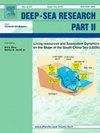西南印度洋生物地球化学浮子部署策略
IF 3
3区 地球科学
Q2 OCEANOGRAPHY
Deep-sea Research Part Ii-topical Studies in Oceanography
Pub Date : 2025-06-24
DOI:10.1016/j.dsr2.2025.105504
引用次数: 0
摘要
最近的路线图IndOOS-2强调了扩大印度洋生物地球化学- argo观测系统的必要性。摩纳哥探险队的印度洋探险队为在西南地区实现这一目标提供了一个独特的机会,在这方面和当时,西南地区是被覆盖最少的海洋地区之一。基于过去的经验、现有的知识和对历史数据集的分析,我们设计了一个生物地球化学浮子阵列的部署策略,以涵盖从塞舌尔-查戈斯温跃层脊到亚热带环流的不同生物物理制度。根据IndOOS-2的建议,在热带带设置了更密集的浮子分布,以加强上升流带的生物地球化学观测。按照这一策略,在2022年10月至11月的考察期间,一支由17个生物地球化学浮标组成的船队成功部署。经过两年的运行,船队覆盖的时空分布证实了部署战略的目标已经实现,揭示了浮游植物生物量经向营养梯度从热带中营养到亚热带少营养的季节性调节。本文章由计算机程序翻译,如有差异,请以英文原文为准。
Biogeochemical float deployment strategy in the Southwestern Indian ocean
The recent roadmap IndOOS-2 has stressed the need to expand the biogeochemical-Argo observing system in the Indian Ocean. The Monaco Explorations Indian Ocean expedition offered a unique opportunity to meet this goal in the southwestern sector which was, in this regard and at that time, one of the least covered oceanic regions. We designed a deployment strategy for the biogeochemical float array grounded on past experiences, existing knowledge, and the analysis of historical datasets to cover the contrasting biophysical regimes from the Seychelles Chagos Thermocline Ridge to the subtropical gyre. Aligning with IndOOS-2 recommendations, a denser float distribution was set in the tropical band to enhance biogeochemical observations in upwelling zones. Following this strategy, a fleet of seventeen biogeochemical floats was successfully deployed during the expedition in October–November 2022. After two years of operations, the spatio-temporal distribution covered by the fleet confirmed that the goals of the deployment strategy have been reached, revealing seasonal modulations of the meridional trophic gradient with respect to phytoplankton biomass from tropical mesotrophy to subtropical oligotrophy.
求助全文
通过发布文献求助,成功后即可免费获取论文全文。
去求助
来源期刊
CiteScore
6.40
自引率
16.70%
发文量
115
审稿时长
3 months
期刊介绍:
Deep-Sea Research Part II: Topical Studies in Oceanography publishes topical issues from the many international and interdisciplinary projects which are undertaken in oceanography. Besides these special issues from projects, the journal publishes collections of papers presented at conferences. The special issues regularly have electronic annexes of non-text material (numerical data, images, images, video, etc.) which are published with the special issues in ScienceDirect. Deep-Sea Research Part II was split off as a separate journal devoted to topical issues in 1993. Its companion journal Deep-Sea Research Part I: Oceanographic Research Papers, publishes the regular research papers in this area.

 求助内容:
求助内容: 应助结果提醒方式:
应助结果提醒方式:


